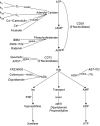Adenosine neuromodulation and traumatic brain injury
- PMID: 20190964
- PMCID: PMC2769006
- DOI: 10.2174/157015909789152137
Adenosine neuromodulation and traumatic brain injury
Abstract
Adenosine is a ubiquitous signaling molecule, with widespread activity across all organ systems. There is evidence that adenosine regulation is a significant factor in traumatic brain injury (TBI) onset, recovery, and outcome, and a growing body of experimental work examining the therapeutic potential of adenosine neuromodulation in the treatment of TBI. In the central nervous system (CNS), adenosine (dys)regulation has been demonstrated following TBI, and correlated to several TBI pathologies, including impaired cerebral hemodynamics, anaerobic metabolism, and inflammation. In addition to acute pathologies, adenosine function has been implicated in TBI comorbidities, such as cognitive deficits, psychiatric function, and post-traumatic epilepsy. This review presents studies in TBI as well as adenosine-related mechanisms in co-morbidities of and unfavorable outcomes resulting from TBI. While the exact role of the adenosine system following TBI remains unclear, there is increasing evidence that a thorough understanding of adenosine signaling will be critical to the development of diagnostic and therapeutic tools for the treatment of TBI.
Keywords: Adenosine deaminase; adenosine kinase; caffeine; comorbidity.; nucleoside transport; nucleotidase.
Figures
Similar articles
-
Suppression of acute proinflammatory cytokine and chemokine upregulation by post-injury administration of a novel small molecule improves long-term neurologic outcome in a mouse model of traumatic brain injury.J Neuroinflammation. 2008 Jun 30;5:28. doi: 10.1186/1742-2094-5-28. J Neuroinflammation. 2008. PMID: 18590543 Free PMC article.
-
Interferon-β Plays a Detrimental Role in Experimental Traumatic Brain Injury by Enhancing Neuroinflammation That Drives Chronic Neurodegeneration.J Neurosci. 2020 Mar 11;40(11):2357-2370. doi: 10.1523/JNEUROSCI.2516-19.2020. Epub 2020 Feb 6. J Neurosci. 2020. PMID: 32029532 Free PMC article.
-
Adenosine A3 receptor as a novel therapeutic target to reduce secondary events and improve neurocognitive functions following traumatic brain injury.J Neuroinflammation. 2020 Nov 12;17(1):339. doi: 10.1186/s12974-020-02009-7. J Neuroinflammation. 2020. PMID: 33183330 Free PMC article.
-
Inflammation in epileptogenesis after traumatic brain injury.J Neuroinflammation. 2017 Jan 13;14(1):10. doi: 10.1186/s12974-016-0786-1. J Neuroinflammation. 2017. PMID: 28086980 Free PMC article. Review.
-
Neurostimulation for traumatic brain injury.J Neurosurg. 2014 Nov;121(5):1219-31. doi: 10.3171/2014.7.JNS131826. Epub 2014 Aug 29. J Neurosurg. 2014. PMID: 25170668 Review.
Cited by
-
Adenosine A2A receptor and glial glutamate transporter GLT-1 are synergistic targets to reduce brain hyperexcitability after traumatic brain injury in mice.Neuropharmacology. 2025 Nov 1;278:110599. doi: 10.1016/j.neuropharm.2025.110599. Epub 2025 Jul 23. Neuropharmacology. 2025. PMID: 40712754 Free PMC article.
-
Poor Sleep Quality is Linked to Elevated Extracellular Vesicle-Associated Inflammatory Cytokines in Warfighters With Chronic Mild Traumatic Brain Injuries.Front Pharmacol. 2022 Jan 27;12:762077. doi: 10.3389/fphar.2021.762077. eCollection 2021. Front Pharmacol. 2022. PMID: 35153739 Free PMC article.
-
The altered TBI fecal microbiome is stable and functionally distinct.Front Mol Neurosci. 2024 Mar 13;17:1341808. doi: 10.3389/fnmol.2024.1341808. eCollection 2024. Front Mol Neurosci. 2024. PMID: 38544523 Free PMC article.
-
Neurotransmitter changes after traumatic brain injury: an update for new treatment strategies.Mol Psychiatry. 2019 Jul;24(7):995-1012. doi: 10.1038/s41380-018-0239-6. Epub 2018 Sep 13. Mol Psychiatry. 2019. PMID: 30214042 Review.
-
When norepinephrine becomes a driver of breathing irregularities: how intermittent hypoxia fundamentally alters the modulatory response of the respiratory network.J Neurosci. 2014 Jan 1;34(1):36-50. doi: 10.1523/JNEUROSCI.3644-12.2014. J Neurosci. 2014. PMID: 24381266 Free PMC article.
References
-
- Abbott CA, Baker E, Sutherland GR, McCaughan GW. Genomic organization, exact localization, and tissue expression of the human CD26 (dipeptidyl peptidase IV) gene. Immunogenetics. 1994;40:331–338. - PubMed
-
- Abrams TW. Cyclic AMP (cAMP) Role in Learning and Memory. In: Squire LR, editor. Encyclopedia of Neuroscience. Oxford: Academic Press; 2009. pp. 265–277.
-
- Al Moutaery K, Al Deeb S, Ahmad Khan H, Tariq M. Caffeine impairs short-term neurological outcome after concussive head injury in rats. Neurosurgery. 2003;53:704–711. discussion 711-702. - PubMed
-
- Almeida T, Rodrigues RJ, de Mendonca A, Ribeiro JA, Cunha RA. Purinergic P2 receptors trigger adenosine release leading to adenosine A2A receptor activation and facilitation of long-term potentiation in rat hippocampal slices. Neuroscience. 2003;122:111–121. - PubMed
-
- Antoni FA. Molecular diversity of cyclic AMP signalling. Front. Neuroendocrinol. 2000;21:103–132. - PubMed
Grants and funding
LinkOut - more resources
Full Text Sources
Research Materials


